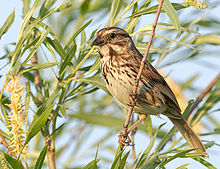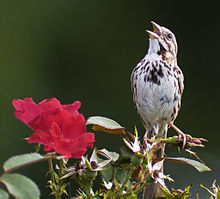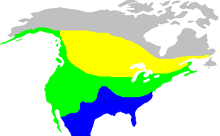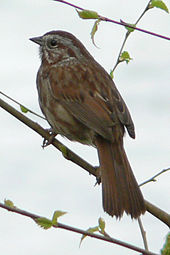- Song Sparrow
-
Song Sparrow 
in Whitby, Ontario, Canada Conservation status Scientific classification Kingdom: Animalia Phylum: Chordata Class: Aves Order: Passeriformes Family: Emberizidae Genus: Melospiza Species: M. melodia Binomial name Melospiza melodia
(Wilson, 1810)Synonyms Melospiza cinerea
The Song Sparrow (Melospiza melodia) is a medium-sized American sparrow.
Adults have brown upperparts with dark streaks on the back and are white underneath with dark streaking and a dark brown spot in the middle of the breast. They have a brown cap and a long brown rounded tail. Their face is grey with a streak through the eye. For subspecies, see below.
In the field, they are most easily confused with its congener the Lincoln's Sparrow, and the Savannah Sparrow. The former can be recognized by its shorter, greyer tail and the differently-patterned head, the brown cheeks forming a clear-cut angular patch. The Savannah Sparrow has a forked tail and yellowish flecks on the face when seen up close.
Although they are a habitat generalist,[1] their favorite habitat is brushy areas and marshes, including salt marshes, across most of Canada and the United States. They also thrive in human areas, such as in suburbs, along edges in agricultural areas, and along roadsides. In southern locations, they are permanent residents. Northern birds migrate to the southern United States or Mexico, where there is also a local population resident all year round. The Song Sparrow is a very rare vagrant to western Europe, with a few recorded in Great Britain and Norway.
These birds forage on the ground, in shrubs or in very shallow water. They mainly eat insects and seeds. Birds in salt marshes may also eat small crustaceans. They nest either in a sheltered location on the ground or in trees or shrubs.
Contents
Eggs
The Song Sparrow lays 3–5 eggs. The egg coloring is a brown spotted greenish-white.
Song
 Singing in Delaware USA
Singing in Delaware USA
The male of this species uses its melodious and fairly complex song to declare ownership of its territory and to attract females.
The Song Sparrow's song consists of a combination of repeated notes, quickly passing isolated notes, and trills. The songs are very crisp, clear, and precise, making them easily distinguishable by human ears. A particular song is determined not only by pitch and rhythm but also by the timbre of the trills. Although one bird will know many songs—as many as 20 different tunes with as many as 1000 improvised variations on the basic theme,[citation needed]—unlike thrushes, the Song Sparrow usually repeats the same song many times before switching to a different song.
Song Sparrows typically learn their songs from a handful of other birds that have neighboring territories. They are most likely to learn songs that are shared in common between these neighbors. Ultimately, they will choose a territory close to or replacing the birds that they have learned from. This allows the Song Sparrows to address their neighbors with songs shared in common with those neighbors. It has been demonstrated that Song Sparrows are able to distinguish neighbors from strangers on the basis of song, and also that females are able to distinguish (and prefer) their mate's songs from those of other neighboring birds, and they prefer songs of neighboring birds to those of strangers.
Other birds such as mockingbirds are not able to effectively imitate the Song Sparrow's song.[citation needed]
Predators and parasites
Common predators of the Song Sparrow include cats, hawks, and owls. Snakes, dogs, and the american kestrel are treated ambiguously, suggesting that they are less of a threat. The Song Sparrow recognizes enemies by both instinctual and learned patterns (including cultural learning), and adjusts its future behavior based on both its own experiences in encounters, and from watching other birds interact with the enemies. Comparisons of experiments on hand-raised birds to observation of birds in the wild suggest that the fear of owls and hawks is instinctual, but fear of cats is learned.[2]
Song Sparrows' nests are parasitized by the brown-headed cowbird. The cowbirds' eggs closely resemble Song Sparrows' eggs, although the cowbirds' eggs are slightly larger. Song Sparrows recognize cowbirds as a threat and attack the cowbirds when they are near the nest. There is some evidence that this behavior is learned rather than instinctual.[2] A more recent study found that the behavior of attacking female cowbirds near nests may actually attract cowbird parasitism because the female cowbirds use such behavior to identify female Song Sparrows that are more likely to successfully raise a cowbird chick.[3] One study found that while cowbird parasitism did result in more nest failure, overall there were negligible effects on Song Sparrow populations when cowbirds were introduced to an island. The study pointed to a number of explanatory factors including Song Sparrows raising multiple broods, and Song Sparrows' abilities to raise cowbird chicks with their own.[4]
Subspecies
The Song Sparrow is one of the birds with the most numerous subspecies in North America, and even on a global scale rivals such species as the Horned Lark, the Yellow Wagtail, the Golden Whistler or the Island Thrush. 52 subspecies were named altogether, of which 24 are considered valid nowadays.[5] It is a cryptic species.
Eastern group
Small, brownish, long-winged forms with strong black streaks.
- Melospiza melodia melodia (Wilson, 1810). The nominate subspecies. Eastern half of North American range except coastal areas south from New York State. In winter, they migrate southeastwards. Very contrasting, very light with black streaks below, and grey margins to back feathers. This population includes the forms named as M. m. juddi Bishop, 1896; M. m. acadica Thayer and Bangs, 1914; M. m. beata (non Bangs) Todd, 1930; M. m. euphonia Wetmore, 1936; M. m. callima Oberholser, 1974; and M. m. melanchra Oberholser, 1974.
- Melospiza melodia atlantica Todd, 1924. Inhabits the Atlantic Coast salt marshes from New York State southwards; does not migrate. Differs from nominate by a gray back. Includes M. m. rossignolii Bailey, 1936.
- Melospiza melodia montana Henshaw, 1884. The subspecies west of melodia to the Rocky Mountains. Some birds from the northern part of its range migrate to NW Mexico in winter. Similar to nominate, but larger, duller coloration and more slender bill. Includes M. m. fisherella Oberholser, 1911.
Northwestern group
Large, dark, diffuse dark streaks. A study of mtDNA allozyme variation of most forms in this group concluded that they are of comparatively recent origin and that island populations are apparently derived independently from each other.[6]
Taken at Springfield, Oregon in early April, this photo probably shows M. m. cleonensis or a "phaea" hybrid
- Melospiza melodia maxima Gabrielson & Lincoln, 1951, Giant Song Sparrow. W Aleutian Islands (Attu to Atka Island), resident. The largest subspecies, about the size of the California Towhee. Very gray overall, long, diffuse streaks. Bill long and slender.
- Melospiza melodia sanaka McGregor, 1901, Aleutian Song Sparrow. Aleutians from Seguam Island east to Stepovak Bay, Alaska, and islands to the south of Alaskan Peninsula; resident. Similar to maxima; grayer still and bill even more slender. Includes the Semidi Song Sparrow, M. m. semidiensis Brooks, 1919, which may be a distinct subspecies however.[7] Also includes the population from Amak Island[8] named M. m. amaka Gabrielson & Lincoln, 1951 (Amak Song Sparrow) which was extirpated due to habitat destruction, apparently disappearing in the weeks around New Year's Eve, 1980/1981 (there were unconfirmed sightings in 1987 and 1988).
- Melospiza melodia insignis Baird, 1869, Bischoff Song Sparrow. Kodiak, Afognak, Sitkalidak, and Raspberry Islands, and Kukak and Katmai on Alaska Peninsula; many migrate south in winter. A darkish grey, medium-sized form.
- Melospiza melodia kenaiensis Ridgway, 1900, Kenai Song Sparrow. Resident; Pacific coast of Kenai Peninsula and Prince William Sound islands; some resident, some migrant. Smaller and browner than insignis.
- Melospiza melodia caurina Ridgway, 1899, Yakutat Song Sparrow. Northern Gulf of Alaska coast, many migrate to Pacific Northwest in winter. A smaller version of kenaiensis.
- Melospiza melodia rufina (Bonaparte, 1850), Sooty Song Sparrow. Outer islands of Alexander Archipelago and Haida Gwaii (Queen Charlotte Islands); most are resident. A very dark, rufous, and small form. Includes M. m. kwaisa Cumming, 1933.
- Melospiza melodia morphna Oberholser, 1899. Coastal region of central British Columbia south to NW Oregon; resident. Lighter, more rufous than rufina. Previously M. m. cinerea (non Gmelin) (Audubon, 1839); M. m. phaea Fisher, 1902 are Central Oregon hybrids between this subspecies and M. m. cleonensis.
- Melospiza melodia merrilli Brewster, 1896. Occurs between the ranges of morphna and montana south to N Nevada; some migrate south in winter. Includes M. m. ingersolli McGregor, 1899 and M. m. inexspectata Riley, 1911 (Riley Song Sparrow; inexpectata is a common lapsus). Doubtfully distinct; intermediate between morphna and montana in appearance also and may be hybrid birds.
- Melospiza melodia cleonensis McGregor, 1899. SW Oregon west of Cascade Mountains south to NW California. Brownish-buffish, notably on the flanks; no grey on back; underside with somewhat diffuse chestnut streaks.
Cismontane California group
Small, well-marked and short-winged brownish forms. All resident, except occasional birds from upland populations.
- Melospiza melodia gouldii Baird, 1858. Coastal central California, except San Francisco Bay. A very brown and clear-marked subspecies; buffish (not light grey) fringes of upper back. M. m. santaecrucis Grinnell, 1901 are hybrids with birds from southwards and Central Valley populations.
- Melospiza melodia samuelis (Baird, 1858), San Pablo Song Sparrow. N San Francisco Bay and San Pablo Bay saltmarshes. A small, tiny-billed subspecies with dirty olive upperpart background.
- Melospiza melodia maxillaris Grinnell, 1909, Suisun Song Sparrow. Suisun Bay marshes. Dark upperparts; brown with grey mantle edges; plump bill base.
- Melospiza melodia pusillula Ridgway, 1899, Alameda Song Sparrow. E San Francisco Bay saltmarshes. Yellowest subspecies, paler than samuelis and clear yellow hue below.
- Melospiza melodia heermanni Baird, 1858. Central coastal California and Central Valley south to N Baja California. Similar in color to maxillaris but medium-sized mainland subspecies. Some N-S variation with birds becoming blacker on backs, local populations once separated as M. m. cooperi Ridgway, 1899 and M. m. mailliardi Grinnell, 1911. The latter, occurring around Modesto, may be distinct.
- Melospiza melodia graminea Townsend, 1890. Described from Santa Barbara Island, California Channel Islands. A smaller, pale-grey version of heermanni. Originally called Santa Barbara Song Sparrow; birds from the Coronado Islands were described as M. m. coronatorum Grinnell and Daggett, 1903, those from San Miguel Island as M. m. micronyx Grinnell, 1928 and those from San Clemente, Santa Rosa and Anacapa Islands as M. m. clementae Townsend, 1890. Hybrid population with heermanni on Santa Cruz Island. Extirpated on Santa Barbara (and possibly San Clemente) by feral cats, c.1967-1970.
Southwestern group
Small, pale, streaks rufous; all resident.
- Melospiza melodia fallax (Baird, 1854), Desert Song Sparrow. Sonoran and parts of Mojave Deserts to E Arizona. A pale ruddy desert form. Synonyms are M. m. saltonis Grinnell, 1909, M. m. virginis Marshall and Behle, 1942 and M. m. bendirei Phillips, 1943.
- Melospiza melodia rivularis Bryant, 1888. Central Baja California. Similar to fallax, lightly streaked breast and long slender bill.
- Melospiza melodia goldmani Nelson, 1899. Not yet found outside El Salto area, Sierra Madre Oriental. Dark reddish brown back with brownish streaks just as in morphna.
Mexican Plateau group
Black-spotted, white throats; all resident.
- Melospiza melodia adusta Nelson, 1899. Río Lerma drainage from Zacapú to Lago Yuriria. Bold black pattern on belly and back, clear white throat. Birds become less ruddy brown going east.
- Melospiza melodia villai Phillips and Dickerman, 1957. Headwaters of Río Lerma near Toluca. Darker and duller brown than adusta, distinctly large.
- Melospiza melodia mexicana Ridgway, 1874. Hidalgo to Puebla. Duller and paler than adusta, birds becoming greyish going south. Includes M. m. azteca Dickerman, 1963 and M. m. niceae Dickerman, 1963. "M. m. pectoralis" (ex von Müller, 1865) cannot be assigned to a known Song Sparrow population.
Conservation status
Seen as a whole, the Song Sparrow is widespread and common to be classified as Species of Least Concern by the IUCN. The taxa mailliardi, maxillaris, samuelis (all Category 3), pusillula (Category 2), and graminea (Category 1) are listed as Species of Special Concern in California.[9]
Notes
- ^ [1] Greenberg, R, " Feeding neophobia and ecological plasticity: A test of the hypothesis with captive sparrows." Animal Behaviour, Vol. 39, No. 2, (1990), pp. 375-379.
- ^ a b [2] Margaret M. Nice; Joost Ter Pelkwyk, "Enemy Recognition by the Song Sparrow" The Auk, Vol. 58, No. 2. (Apr., 1941), pp. 195-214.
- ^ [3] James N. M. Smith1, Peter Arcese1 and Ian G. McLean, " Age, experience, and enemy recognition by wild song sparrows", Behavioral Ecology and Sociobiology, Vol. 14, No. 2 (Feb., 1984) pp. 101-106.
- ^ [4] James N. M. Smith; Peter Arcese, "Brown-Headed Cowbirds and an Island Population of Song Sparrows: A 16-Year Study", The Condor, Vol. 96, No. 4. (Nov., 1994), pp. 916-934.
- ^ Patten (2001), Arcese et al. (2002)
- ^ Hare & Shields (1992)
- ^ Gabrielson & Lincoln (1951)
- ^ Pruett et al. (2004)
- ^ CDFG (2006)
References
- Arcese, P.; Sogge, M.K.; Marr, A.B. & Patten, M.A. (2002): Song Sparrow (Melospiza melodia). In: Poole, A. & Gill, F.: The Birds of North America 704. The Birds of North America, Inc., Philadelphia, PA.
- Beecher, M.D.; Campbell, S.E. & Stoddard, P.K. (1994): Correlation of Song Learning and Territory Establishment Strategies in the Song Sparrow. Proc. Natl. Acad. Sci. USA 91(4): 1450-1454. PDF fulltext
- BirdLife International (2004). Melospiza melodia. 2006. IUCN Red List of Threatened Species. IUCN 2006. www.iucnredlist.org. Retrieved on 12 May 2006. Database entry includes justification for why this species is of least concern
- California Department of Fish and Game (CDFG) (2006): California Bird Species of Special Concern.
- Gabrielson, Ira N. & Lincoln, Frederick C. (1951): The Races of Song Sparrows in Alaska. Condor 53(5): 250-255. PDF fulltext
- Hare, M.P. & Shields, G.F. (1992): Mitochondrial-DNA variation in the polytypic Alaskan song sparrow. Auk 109(1): 126-132. PDF fulltext
- O'Loghlen, A.L. & Beecher; M.D. (1997): Sexual preferences for mate song types in female song sparrows. Animal Behavior 53(4): 835-841. PDF fulltext
- Patten, M.A. (2001): The roles of habitat and signalling in speciation: evidence from a contact zone of two Song Sparrow (Melospiza melodia) subspecies. Ph.D. diss., Univ. of California, Riverside.
- Pruett, Christin; Gibson, Daniel D. & Winker, Kevin (2003): Amak Island Song Sparrows (Melospiza melodia amaka) are not evolutionarily significant. Ornithological Science 3: 133–138. doi:10.2326/osj.3.133 PDF fulltext
- Smith, J.N.M.et al. (1997): A metapopulation approach to the population biology of the Song Sparrow Melospiza melodia. Ibis 138:4, 120-128 Online publication date: 1-Jan-1997.
- Stoddard, Beecher, M.D.; Horning, C.L. & Campbell, S.E. (1991): Recognition of individual neighbors by song in the song sparrow, a species with song repertoires. Behavioral Ecology and Sociobiology 29(3): 211-215.
External links
- Interesting Song Sparrow Facts donated by BirdHouses101.com
- Song Sparrow Species Account - Cornell Lab of Ornithology
- Song Sparrow Information and Photos - South Dakota Birds and Birding
- Song Sparrow Melospiza melodia USGS Patuxent Bird Identification InfoCenter
- Song Sparrow videos on the Internet Bird Collection
- Song Sparrow photo gallery VIREO
Categories:- IUCN Red List least concern species
- Melospiza
- Birds of North America
- Birds of Canada
- Birds of the United States
- Native birds of Alaska
- Birds of Mexico
- Fauna of Northern Mexico
- North American migratory birds
Wikimedia Foundation. 2010.



